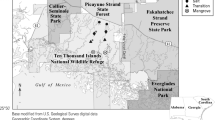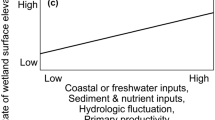Abstract
Soil elevation affects tidal inundation period, inundation frequency, and overall hydroperiod, all of which are important ecological factors affecting species recruitment, composition, and survival in wetlands. Hurricanes can dramatically affect a site’s soil elevation. We assessed the impact of Hurricane Wilma (2005) on soil elevation at a mangrove forest location along the Shark River in Everglades National Park, Florida, USA. Using multiple depth surface elevation tables (SETs) and marker horizons we measured soil accretion, erosion, and soil elevation. We partitioned the effect of Hurricane Wilma’s storm deposit into four constituent soil zones: surface (accretion) zone, shallow zone (0–0.35 m), middle zone (0.35–4 m), and deep zone (4–6 m). We report expansion and contraction of each soil zone. Hurricane Wilma deposited 37.0 (±3.0 SE) mm of material; however, the absolute soil elevation change was + 42.8 mm due to expansion in the shallow soil zone. One year post-hurricane, the soil profile had lost 10.0 mm in soil elevation, with 8.5 mm of the loss due to erosion. The remaining soil elevation loss was due to compaction from shallow subsidence. We found prolific growth of new fine rootlets (209 ± 34 SE g m−2) in the storm deposited material suggesting that deposits may become more stable in the near future (i.e., erosion rate will decrease). Surficial erosion and belowground processes both played an important role in determining the overall soil elevation. Expansion and contraction in the shallow soil zone may be due to hydrology, and in the middle and bottom soil zones due to shallow subsidence. Findings thus far indicate that soil elevation has made substantial gains compared to site specific relative sea-level rise, but data trends suggest that belowground processes, which differ by soil zone, may come to dominate the long term ecological impact of storm deposit.
Similar content being viewed by others
Literature Cited
Anderson, G. H., K. M. Balentine, K. R. T. Whelan, and T. J. Smith III. 2007. Observations of mangrove fine roots in Hurricane Wilma Storm deposits one year post impact: Shark River, Everglades National Park, USA. National Conference on Ecosystem Restoration, Kansas City, MO.
Baldwin, A., M. Egnotovich, M. Ford, and W. Platt. 2001. Regeneration in fringe mangrove forests damaged by Hurricane Andrew. Plant Ecology 157: 151–64.
Cahoon, D. R. 2006. A review of major storm impacts on coastal wetland elevations. Estuaries and Coasts 29: 889–98.
Cahoon, D. R., D. J. Reed, and J. W. Day, Jr. 1995. Estimating shallow subsidence in microtidal salt marshes of the southeastern United States: Kaye and Barghoorn revisited. Marine Geology 128: 1–9.
Cahoon, D. R. and J. C. Lynch. 1997. Vertical accretion and shallow subsidence in a mangrove forest of southwestern Florida, U.S.A. Mangroves and Salt Marshes 1: 173–86.
Cahoon, D. R., J. Day, and D. Reed. 1999. The influence of surface and shallow subsurface soil processes on wetland elevation: a synthesis. Current Topics in Wetland Biogeochemistry 3: 72–88.
Cahoon, D. R., P. R. Hensel, J. Rybczyk, K. L. McKee, E. E. Proffitt, and B. C. Perez. 2003. Mass tree mortality leads to mangrove peat collapse at Bay Islands, Honduras after Hurricane Mitch. Journal of Ecology 91: 1093–1105.
Cahoon, D. R., J. C. Lynch, P. Hensel, R. Boumans, B. C. Perez, B. Segura, and J. W. Day, Jr. 2002a. A device for high precision measurement of wetland sediment elevation: I. Recent improvements to the sedimentation-erosion table. Journal of Sedimentary Research 72: 734–39.
Cahoon, D. R., J. C. Lynch, B. C. Perez, B. Segura, R. Holland, C. Stelly, G. Stephenson, and P. Hensel. 2002b. A device for high precision measurement of wetland sediment elevation: II. The rod surface elevation table. Journal of Sedimentary Research 72: 734–39.
Cohen, A. D. 1968. The petrology of some peats of southern Florida (with special reference to the origin of coals). Dissertation, Pennsylvania State University. Pennsylvania, USA 1: 332–34.
Cornu, C. E. and S. Sadro. 2002. Physical and functional responses to experimental marsh surface elevation manipulation in Coos Bay’s South Slough. Restoration Ecology 10: 474–86.
Craighead, F. C. Jr. and V. C. Gilbert. 1962. The effects of Hurricane Donna on the vegetation of southern Florida. Quarterly Journal of the Florida Academy of Science 25: 1–28.
Davis, S. E., J. Cable, C. Childers, C. Coronado, J. Day, C. Hittle, C. Madden, E. Reyes, D. Rudnick, and F. Sklar. 2004. Importance of episodic storm events in controlling ecosystem structure and function in a Gulf Coast estuary. Journal of Coastal Research 20: 1198–1208.
Ellison, A. M. and E. J. Farnsworth. 1993. Seedling survivorship, growth, and response to disturbance in Belizean mangal. American Journal of Botany 80: 1137–45.
Goldenburg, S., C. Landsea, A. Mestas-Nunez, and W. Gray. 2001. Increase in Atlantic hurricane activity: causes and implications. Science 293: 474–79.
Kaye, C. A. and E. S. Barghoon. 1964. Late Quaternary sea-level change and crustal rise at Boston, Massachusetts, with notes on the autocompaction of peat. Geological Society of America Bulletin 75: 63–80.
Keim, B. D., R. A. Muller, and G. W. Stone. 2007. Spatiotemporal patterns and return periods of tropical storm and hurricane strikes from Texas to Maine. Journal of Climate 20: 3498–3509.
Krauss, K. W., T. W. Doyle, R. R. Twilley, T. J. Smith III, K. R. T. Whelan, and J. K. Sullivan. 2005. Woody debris in the mangrove forests of South Florida. Biotropica 37: 9–15.
Krauss, K. W., T. W. Doyle, T. J. Doyle, C. M. Swarzenski, A. S. From, R. H. Day, and W. H. Conner. 2009. Water level observations in mangrove swamps during two hurricanes in Florida. Wetlands 29: 142–149.
Lugo, A. E. and S. C. Snedaker. 1974. The ecology of mangroves. Annual Review of Ecology and Systematics 5: 39–64.
Maul, G. A. and D. M. Martin. 1993. Sea level rise at Key West, Florida, 1846–1992: America’s longest instrument record? Geophysical Research Letters 20: 1955–58.
Micheli, E. R. and J. W. Kirchner. 2002. Effects of wet meadow riparian vegetation on stream bank erosion. 2. measurement of vegetated bank strength and consequences for failure mechanics. Earth Surface Processes and Landforms 27: 687–97.
National Oceanic and Atmospheric Administration. 2005. National Weather Service, Hurricane Wilma, Figure 9, www. srh.noaa.gov/mfl/events/?id=Wilma last updated 10/30/2005 web accessed March 10, 2008.
Oberbauer, S. F., K. von Kleist III, K. R. T. Whelan, and S. Koptur. 1996. Effects of Hurricane Andrew on epiphyte communities within cypress domes of Everglades National Park. Ecology 77: 964–67.
Pasch, R. J., E. S. Blake, H. D. Cobb III, and D. P. Roberts. 2006. Tropical cyclone report, Hurricane Wilma, 15–25 October 2005. National Hurricane Center, 12 January 2006.
Rabinowitz, D. 1978b. Early growth of mangrove seedlings in Panama, and a hypothesis concerning the relationship of dispersal and zonation. Journal of Biogeography 5: 113–33.
Resio, D. T. and J. J. Westerink. 2008. Modeling the physics of storm surges. Physics Today 61: 33–38.
Risi, J. A., H. Wanless, L. P. Tedesco, and S. Gelsanliter. 1995. Catastrophic sedimentation from Hurricane Andrew along the southwest Florida coast. Journal of Coastal Research 21: 83–102.
Shein, K. A. 2006. 2005. State of the Climate Contributing Editors A.M. Waple, H.J. Diamond, and J.M. Levy NOAA/ NESDIS/NCDC and American Meteorological Society.
Smith, T. J. III, G. H. Anderson, K. Balentine, G. Tiling, G. Ward, and K. R. T. Whelan. 2009. Cumulative impacts of hurricanes on Florida managrove ecosystems: Sediment deposition, storm surges, and vegetation. Wetlands 29: 24–34.
Turner, R. E., J. J. Baustian, E. M. Swenson, and J. S. Spicer. 2006. Wetland sedimentation from Hurricanes Katrina and Rita. Science 314: 449–52.
Ugarte, C. A., L. A. Brandt, S. Melvin, F. J. Mazzotti, and K. G. Rice. 2006. Hurricane impacts to tree islands in Arthur R. Marshall Loxahatchee National Wildlife Refuge, Florida Southeastern Naturalist 5: 737–46.
Wanless, H., R. Parkinson, and L. Tedesco. 1994. Sea Level control on stability of Everglades wetlands, p. 199–223. In S. Davis and J. Ogden (eds.) Everglades: The Ecosystem and Its Restoration. St. Lucie Press, Boca Raton, FL, USA.
Whelan, K. R. T. 2005. The successional dynamics of lightning-initiated canopy gaps in mangrove forests of Shark River, Everglades National Park, USA. Dissertation, Florida International University, Miami, Fla, USA.
Whelan, K. R. T., T. J. Smith III, D. R. Cahoon, J. C. Lynch, and G. H. Anderson. 2005. Groundwater control on mangrove surface elevation: shrink and swell varies with soil depth. Esutaries 28: 833–43.
Author information
Authors and Affiliations
Corresponding author
Rights and permissions
About this article
Cite this article
Whelan, K.R.T., Smith, T.J., Anderson, G.H. et al. Hurricane Wilma’s impact on overall soil elevation and zones within the soil profile in a mangrove forest. Wetlands 29, 16–23 (2009). https://doi.org/10.1672/08-125.1
Received:
Accepted:
Issue Date:
DOI: https://doi.org/10.1672/08-125.1




